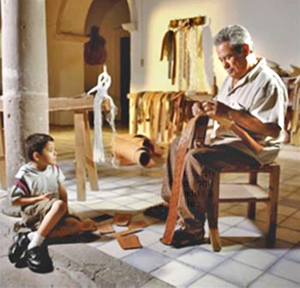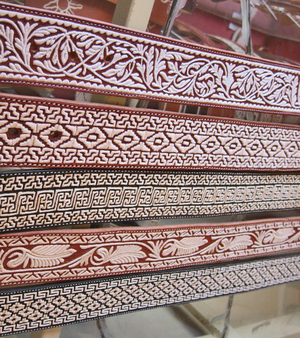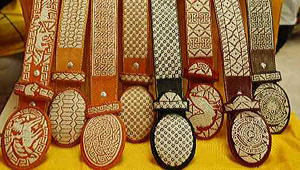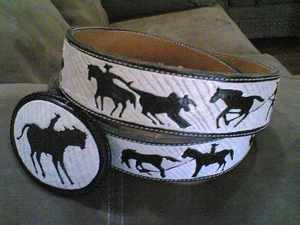It’s Sunday morning just before dawn. A vaquero (cowboy) in his best jeans and sombrero swaggers into the courtyard of the hacienda. His boot heels click softly on the red clay tiles of the patio. As the sun breaks over the barn roof, the mustachioed vaquero
chooses his best saddle from its wooden stand and carefully cinches it
around the belly of his favorite mount. He’s off to town, both he and
his horse dressed carefully for their day off.
Let’s take a closer look at the cowboy’s boots, his belt and his
saddle. Each of them is hand-embroidered using an ancient Mexican
technique called piteadao.
To understand the process of the embroidery, we travel to the southern
jungles of Mexico, to the states of Oaxaca and Chiapas, where the tall
trees grow, where coffee is grown, where the air is steamy and thick
with humidity. Under the shelter of the jungle trees, the smaller
plants grow away from the glare of the sun.
The thread used for the embroidery is processed from a bromeliad plant called ixtle.
The plant, grown as undergrowth in tropical jungles, eco-forests, or
coffee plantations, takes approximately eight years to grow to
maturity. Usually the entire plant is harvested, allowing better and
faster growth of the young plants which have sprung up much like baby spider plants. However, only the longest and healthiest
leaves of the ixtle plant are used to produce thread.
The preparation of pita, the ixtle thread, is time consuming and arduous. The long leaves are scraped, either manually or using a hand-cranked machine, to free the ixtle
fibers. The fibers are then washed several times and hung in the sun to
bleach. Once they are bleached, they are combed and braided into
bundles called muñecas (bunches), which are sold to talabarteros(saddle
makers and artisan leather goods workers) working primarily in the town
of Colotlán, in Los Altos—the northern highland region—of Jalisco.
Colotlán is considered to be the world capital of piteado. There are more than 40 workshops producing pita-embroidered
leather goods in the town, plus 200 private micro-businesses producing
the work. Nearly 2800 townspeople dedicate their daily work lives to
this art. Their hand sewn products include belts, boots, sandals,
briefcases, wallets, purses, and their crowning achievement, saddles.
The work from this village is so well known that several belts from
Colotlán are exhibited in the renowned Prado Museum in Madrid.
The practice of the art of piteado, which has given
this town and the region international fame, dates to the last decade
of the 19th Century. This craft has been passed from father to son
through the course of generations. Today, approximately 10,000 belts
are produced in the town each month. The belts are sold everywhere in
Mexico and are shipped to international destinations such as the United
States, where a piteado belt is a hallmark of many Mexican men.
These handmade goods are not inexpensive: you’ll find less expensive imitation piteado,
sewn by machine using cotton thread, but almost all of the hand made
work is still done in Colotlán. Expect good quality genuine piteado belts to cost several hundred dollars.
There are many individual steps that lead to a finished product. Traditionally, piteado
artisans have worked individually in all of the different stages of
production, from design work to marketing. In some respects this has
limited the development of piteado as an industry, but it has ensured
the continuing tradition of the work.
Piteado is worked only on leather, most of which is brought to
Colotlán from León, Guanajuato or from San Luís Potosí. The original
designs came from Aztec traditions, but those designs have gradually
been modified over the years and have lost some of the flavor of that
culture. Today, many of the designs include Huichol elements due to the
influence of that indigenous people in the area of Colotlán. Some of
the commercial workshops have more modern designs, such as flowers and
horse heads, adapted to the requests of the customer.
The production of belts is the bread and butter of the piteado
artisans in Colotlán. Most of the belts are sold at fairs and in stores
throughout Mexico. In my travels around Guadalajara, I sometimes see
ambulatory vendors selling piteado belts. If you make a
trip to the Mercado Libertad in Guadalajara’s Centro Histórico, you’ll find
hundreds of belts, boots, huaraches, and every other sort of piteado leather goods. Be aware that when you’re shopping for piteado and the price seems too good to be true—and the dealer swears that his products are the real piteado, hand-sewn from pita fiber—you’re probably hearing a sales pitch for inferior goods sewn with cotton. Most of these pirated imitation piteado items come from the Guadalajara area.
It’s difficult work to hand embroider a belt. The production of each
one takes a single worker a full week to complete. First, the size and
shape of each belt are traced onto the leather; then the leather is cut
into strips. Each strip is then shaped and polished. The design or
drawing for the embroidery is hand-cut into the leather with a chisel.
Once the leather is ready, the most difficult part of the work begins:
the embroidery. The mesquite wood needle is punched through the leather
using a hammer and an awl.
Using a heavy duty sewing machine, the embroiderer sews the lining to
the back of the belt, cuts it, and hand-finishes it. Finally, another
person adds the buckle, the closure, and the loops that hold the end of
the belt when it’s fastened around the buyer’s waist. Any leftover
leather is used to make brooches, earrings, pins, and other small
goods. It’s all a question of not wasting any costly materials.
The most difficult work is called alamar doble, a term that
has no adequate translation into English. The work is complex and
baroque and so specialized that almost no one outside the town of
Colotlán tries it. In the rare instances when it’s copied, a buyer in
the know will recognize that the work is done with cotton thread and is
a poor imitation of genuine piteado from Colotlán.
In Colotlán, Armando Gaeta Loera is one of the acknowledged maestros of piteado.
He began to study the art when he was barely eighteen years old. For
two years he worked as an apprentice with Rafael de León. Later he and
his wife opened their own shop. With time, he hired assistants and as
the years passed, his three sons have entered into the family business.
Today he has two workshops, one in Jerez, Zacatecas and the other in
Colotlán.
Maestro Gaeta designs and makes bags, belts, holsters for pistols and knives, cases for machetes, boots, chaps, and sombreros of piteado,
along with other smaller articles for both men and women. He uses
leather from a variety of animals: cattle, goat, sheep, deer and fox,
among others. For finely detailed work, he chooses suede and other
special leathers that are the softest and therefore least difficult to
embroider.
The work is demanding. Maestro Gaeta is often called upon
to prepare special designs for his clients, designs which incorporate
specific emblems, flowers, names, initials, or animals. The prepared
leather is properly flattened and stretched before the parts of a piece
are cut and before the design to be embroidered is traced onto the
skin. This planchada—literally, ‘ironing’—is always done from the reverse side of the leather.
After further hand processing, the designs are distributed over the surface of the leather. Maestro Gaeta
uses a hard lead pencil, a wooden square, a ruler, a marker, and a
metal compass—all the usual tools—to trace the intertwined flowers and
foliage, the horse heads, the initials or names of the owner of the
piece, and any other special requests onto the leather.
Once the drawings are finished, they are marked with a marker and Maestro Gaeta begins to make tiny holes in the leather with an awl. He then begins, little by little, to embroider with the pita,
twisted in two or three strand lengths, depending on the design and the
depth of the relief that he wants to give the embroidery. The sections
of the piece he’s making are then joined either with a hand needle or
with a special sewing machine that is exclusively for this kind of
leather work. If the piece requires a fabric lining, this is the time
it’s put into place.
The finished piteado, whether belt, boots, or saddle, is highly prized by the owner and may well be worn during competition in championship charreada, the stylized Mexican horsemanship competitions.
You’re well on your way to being a connoisseur of the fine and macho art of piteado.
If you are reading this while you’re living North of the Border, be
sure to look at the belts you see worn by Mexican men in your area.
You’ll see examples of the art of piteado and you’ll know exactly how they’re made and where they originate.
All photos courtesy of http://www.colotlan2.com/





Leave a Reply to Bgreig Cancel reply